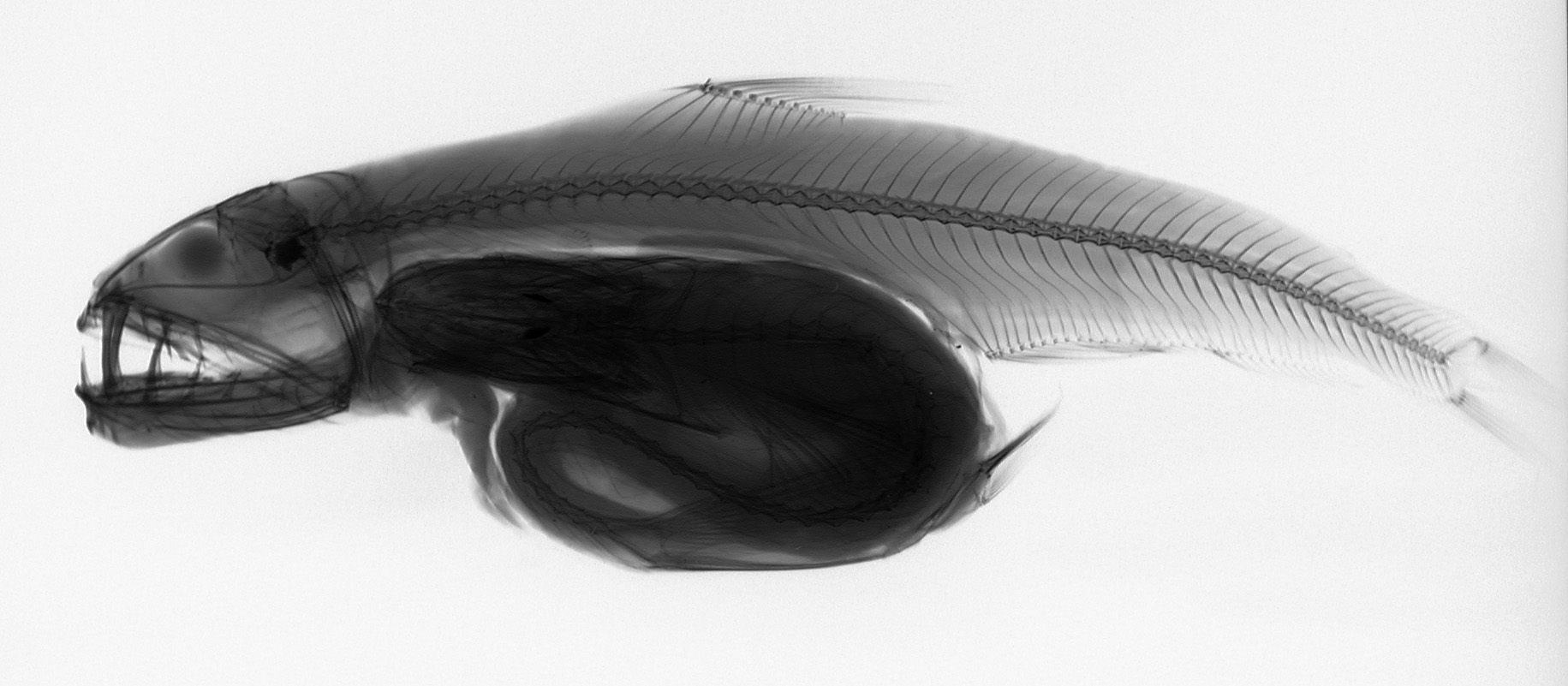Atlantic Sabretooth, Coccorella atlantica (Parr 1928)

An x-ray of an Atlantic Sabretooth, Coccorella atlantica showing its enormous teeth and full stomach. Source: Martin Gomon / Museum Victoria. License: CC BY Attribution
Voracious mesopelagic predators with dorsolaterally-directed semi-tubular eyes, and large mouths with enormous fang-like teeth in the lower jaw and roof of the mouth.
Sabretooth fishes have extremely distensible stomachs and can swallow very large prey items. They are synchronous hermaphrodites, meaning that they have functional male and female reproductive tissue at the same time.
Atlantic Sabretooth, Coccorella atlantica (Parr 1928)
More Info
|
Distribution |
Circumglobal in tropical and temperate waters between about 10° and 35° latitude. The Atlantic Sabretooth lives in oceanic midwaters at depths of 50-500 m in Australian waters, 50-1000 m elsewhere. |
|
Features |
Meristic features: Dorsal-fin rays 11-13; Anal-fin rays 26-30; Caudal-fin rays 19; Pectoral-fin rays 12-13; Pelvic-fin rays 9; Vertebrae 48-50. Moderately elongate, compressed, deepwater fishes of open ocean with large mouth and prominent teeth, anteriormost pair on roof of mouth produced into enormous fangs; lower jaw deep and massive, upper and lower muscle masses on rear of body separated by distinct 3rd midlateral muscle band, and no fleshy keels on caudal peduncle or normal scales; gill rakers absent. Centre of short-based dorsal fin just forward of middle of back, prominent adipose dorsal fin posteriorly, moderately long-based anal fin just before tail, caudal fin deeply forked and pectoral fins prominent; lateral line midlaterally on side. |
|
Size |
18.5 cm SL |
|
Colour |
Iridescent brassy-brown with scattered small black spots, especially along the ventral midline and the anal-fin base; dorsal surface and midlateral muscle mass slightly darker. |
|
Feeding |
Carnivore - a visual predator that feeds on fishes and cephalopods. Sabretooth fishes have highly distensible stomachs and can swallow very large prey. |
|
Fisheries |
Of no interest to fisheries |
|
Conservation |
IUCN Red List: Least Concern |
|
Species Citation |
Evermannella atrata atlantica Parr, 1928, Bull. Bingham Oceanogr. Collect. Yale Univ. 3(3): 166, figs 39B, 40B Type locality: Tongue of the Ocean, Bahamas, 23°58'N, 77°26'W. |
|
Author |
Dianne J. Bray & Martin F. Gomon |
Atlantic Sabretooth, Coccorella atlantica (Parr 1928)
References
Carpenter, K.E. 2015. Coccorella atlantica. The IUCN Red List of Threatened Species 2015: e.T47164926A47461936. http://dx.doi.org/10.2305/IUCN.UK.2015-4.RLTS.T47164926A47461936.en. Downloaded on 28 August 2016.
Johnson, R.K. 1982. Fishes of the families Evermannellidae and Scopelarchidae: systematics, morphology, interrelationships and zoogeography. Fieldiana Zoology ns 12: 1-252 figs 1-74
Johnson, R.K. 1986. Evermannellidae. p. 278-280. In M.M. Smith and P.C. Heemstra (eds.) Smiths' sea fishes. Springer-Verlag, Berlin.
Parr, A.E. 1928. Deep sea fishes of the order Iniomi from the waters around the Bahama and Bermuda Islands, with annotated keys to the Sudidae, Myctophidae, Scopelarchidae, Evermannellidae, Omosudidae, Cetomimidae and Rondeletiidae of the world. Bulletin of the Bingham Oceanographic Collection 3(3): 1-193 figs 1-43
Paxton, J.R. & Niem, V.H. 1999. Families Paralepididae, Anotopteridae, Evermannellidae, Omosudidae, Alepisauridae, Giganturidae. pp. 1948-1954 in Carpenter, K.E. & Niem, V.H. (eds). The Living Marine Resources of the Western Central Pacific. FAO Species Identification Guide for Fisheries Purposes. Rome : FAO Vol. 3 1397-2068pp.
Rofen, R.R. 1966. Family Evermannellidae. In: Fishes of the Western North Atlantic. Mem. Sears Fnd. Mar. Res. I(5): 511–565.

